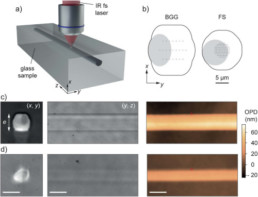Direct-laser-written integrated mid-IR directional couplers in a BGG glass
Category : Publications | Date : Mar 5, 2021
Arthur Le Camus, Yannick Petit, Jean-Philippe Bérubé, Matthieu Bellec, Lionel Canioni, and Réal Vallée
Optics Express Vol. 29, Issue 6, pp. 8531-8541 (2021)
The development of coherent sources and other optical components for the mid-infrared has been hampered by the lack of sturdy materials that can withstand high power radiation or exposition to harsh environment. BGG glasses are robust materials transmitting over the 2.5–5 μm region. We report here the direct femtosecond laser fabrication of efficient directional couplers integrated in a BGG glass chip. The photonic components are characterized from 2.1 to 4.2 μm and compared to similar structures inscribed in silica glass samples. At 2.85 μm, a 99% relative cross transmission is reported in BGG glass. The experimental measurements are in good agreement with the coupled mode theory for wavelengths up to 3.5 μm.

